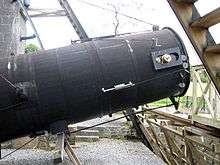Birr Castle
Birr Castle (Irish: Caisleán Bhiorra)[1] is a large castle in the town of Birr in County Offaly, Ireland. It is the home of The 7th Earl of Rosse, and as such the residential areas of the castle are not open to the public,[2] though the grounds and gardens of the demesne are publicly accessible.


Ireland's Historic Science Centre
The castle grounds are also home to Ireland's Historic Science Centre, a museum of Ireland's historic scientists and their contributions to astronomy and botany.[3]
History
There has been a castle on the site since 1170, and from the 14th to the 17th century the O'Carroll family ruled from here over an area known as "Ely O'Carroll".[4]
After the death of Sir Charles O'Carroll, Sir Laurence Parsons (died 1628) was granted Birr Castle and 1,277 acres (5.2 km2) of land in 1620.[5][6] Parsons engaged English masons in the construction of a new castle on the site. This construction took place, not on the site of the O'Carroll's Black Tower (since disappeared), but at its gatehouse. "Flankers" were added to the gatehouse diagonally at either side, giving the castle the plan it retains today.[5]
After the death of Sir Laurence Parsons and of his elder son Richard, the castle passed to his younger son William.[7] During the Irish Rebellion of 1641 William was besieged at Birr for fifteen months by Catholic forces. After the civil war, William's son Laurence (baronet from 1677) refurnished the castle.
A later descendant, The 2nd Earl of Rosse, also engaged in some re-building, and heightened and "Gothicised" the castle in the early 19th century. In turn, his son, The 3rd Earl of Rosse, was responsible for the construction of the great telescope at Birr. When completed in 1845, it was the largest telescope on earth, and capable of capturing more light and seeing further into space than any telescope had done before. Birr therefore became a focus for astronomical observations, and visitors came to visit the observatory from all over the world - including Charles Babbage and H.I.H. Napoléon Eugène, Prince Imperial.[5]
When the 3rd Earl died, his sons carried on the scientific tradition, and The 4th Earl of Rosse is noted for measuring the heat of the moon. After his death in 1908, however, the telescope fell into disrepair; the mirror was taken to the Science Museum in London, and, circa 1914, the telescope's metal supporting structure was melted down to be used in the First World War. In 1925 the wooden structures around the walls were demolished for safety reasons. Following several intermediate restoration attempts, the telescope was restored more completely in the late 1990s.[8]
The "Great Telescope" and other features

A main feature on the grounds of the castle is the "Great Telescope" or Leviathan of Parsonstown or The Rosse Telescope) of the third Earl of Rosse, an astronomical telescope with a 183-cm (72 in) reflector. It was completed in 1845 and was used for several decades before the last observations were made in the first years of the 20th century. Its record size was not surpassed until the completion of the 100-inch (2.5-meter) Hooker Telescope at Mount Wilson Observatory in 1917. It was dismantled in 1914, but the structure was restored and the telescope reconstructed in the 1990s and is open to the public.
In 2017, LOFAR radio-telescope station IE613 was constructed in the grounds of the castle.[9] This is the westernmost station in the LOFAR network. The I-Lofar telescope, in 2018, observed for the first time a billion-year-old red-dwarf, flare star called CN Leo, almost 75 trillion kilometres away.[10]
Laurence Parsons, 4th Earl of Rosse and his mother, Mary Parsons, Countess of Rosse, were eminent photographers and her darkroom, which is also on show, is believed to be the oldest surviving example in the world.
The grounds of the castle contain the oldest wrought-iron bridge in Ireland, dating from 1820.[11]
The walled gardens in the grounds feature Box Hedges that are over 300 years old. They are also, according to The Guinness Book of Records, the tallest hedge in the world.[12]
The Irish entry to the 2014 European Tree of the Year contest was the Birr Castle Grey Poplar (Populus x canescens). On 12 February 2014, while voting was still open, it was blown down in a storm.[13]
Notes
- "Archived copy". Archived from the original on 17 November 2017. Retrieved 14 June 2012.CS1 maint: archived copy as title (link)
- The Birr Scientific and Heritage Foundation. "Birr Castle". BirrCastle.com. Archived from the original on 21 September 2008.
- The Birr Scientific and Heritage Foundation. "Ireland's Historic Science Centre". BirrCastle.com. Archived from the original on 18 September 2008.
- The Birr Scientific and Heritage Foundation. "Birr Castle Grounds". BirrCastle.com. Archived from the original on 21 January 2008.
- The Birr Scientific and Heritage Foundation. "Birr Castle, Co. Offaly". Archived from the original on 7 August 2008.
- Lundy 2011, i15200 cites: Mosley 2003, p. 1327
- The Birr Scientific and Heritage Foundation. "Birr Castle demesne, Voyage of discovery: Family History". Archived from the original on 15 January 2012. Retrieved March 2012. Check date values in:
|accessdate=(help) - Detail on telescope reconstruction Archived 27 September 2008 at the Wayback Machine
- "The BUild - I-LOFAR". Archived from the original on 30 June 2018. Retrieved 28 December 2017.
- Birr radio telescope catches flaring red dwarf 75 trillion kilometres away Irish Times, 2018-03-27.
- The Rough Guide to Ireland, 9th Edition; p 219 ISBN 978-1-85828-056-1
- "The Box Hedge". Archived from the original on 1 July 2008. Retrieved 15 November 2007.
- https://www.irishtimes.com/life-and-style/homes-and-property/gardens/storm-casualties-ireland-s-lost-trees-1.1706766
References
- Lundy, Darryl (27 August 2011). "Sir Laurence Parsons".CS1 maint: ref=harv (link)
- Mosley, Charles, ed. (2003). Burke's Peerage, Baronetage & Knightage (3 volumes). 1 (107th ed.). Wilmington, Delaware, U.S.A.: Burke's Peerage (Genealogical Books) Ltd. p. 1327.CS1 maint: ref=harv (link)

